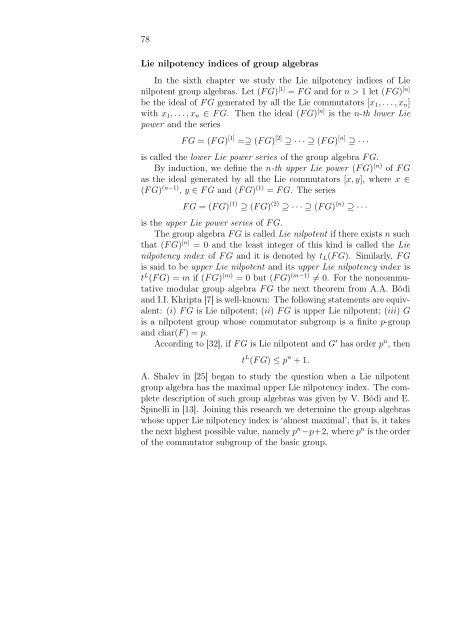On the Derived Length of Lie Solvable Group Algebras
On the Derived Length of Lie Solvable Group Algebras
On the Derived Length of Lie Solvable Group Algebras
Create successful ePaper yourself
Turn your PDF publications into a flip-book with our unique Google optimized e-Paper software.
78<br />
<strong>Lie</strong> nilpotency indices <strong>of</strong> group algebras<br />
In <strong>the</strong> sixth chapter we study <strong>the</strong> <strong>Lie</strong> nilpotency indices <strong>of</strong> <strong>Lie</strong><br />
nilpotent group algebras. Let (F G) [1] = F G and for n > 1 let (F G) [n]<br />
be <strong>the</strong> ideal <strong>of</strong> F G generated by all <strong>the</strong> <strong>Lie</strong> commutators [x1, . . . , xn]<br />
with x1, . . . , xn ∈ F G. Then <strong>the</strong> ideal (F G) [n] is <strong>the</strong> n-th lower <strong>Lie</strong><br />
power and <strong>the</strong> series<br />
F G = (F G) [1] =⊇ (F G) [2] ⊇ · · · ⊇ (F G) [n] ⊇ · · ·<br />
is called <strong>the</strong> lower <strong>Lie</strong> power series <strong>of</strong> <strong>the</strong> group algebra F G.<br />
By induction, we define <strong>the</strong> n-th upper <strong>Lie</strong> power (F G) (n) <strong>of</strong> F G<br />
as <strong>the</strong> ideal generated by all <strong>the</strong> <strong>Lie</strong> commutators [x, y], where x ∈<br />
(F G) (n−1) , y ∈ F G and (F G) (1) = F G. The series<br />
F G = (F G) (1) ⊇ (F G) (2) ⊇ · · · ⊇ (F G) (n) ⊇ · · ·<br />
is <strong>the</strong> upper <strong>Lie</strong> power series <strong>of</strong> F G.<br />
The group algebra F G is called <strong>Lie</strong> nilpotent if <strong>the</strong>re exists n such<br />
that (F G) [n] = 0 and <strong>the</strong> least integer <strong>of</strong> this kind is called <strong>the</strong> <strong>Lie</strong><br />
nilpotency index <strong>of</strong> F G and it is denoted by tL(F G). Similarly, F G<br />
is said to be upper <strong>Lie</strong> nilpotent and its upper <strong>Lie</strong> nilpotency index is<br />
t L (F G) = m if (F G) (m) = 0 but (F G) (m−1) = 0. For <strong>the</strong> noncommutative<br />
modular group algebra F G <strong>the</strong> next <strong>the</strong>orem from A.A. Bódi<br />
and I.I. Khripta [7] is well-known: The following statements are equivalent:<br />
(i) F G is <strong>Lie</strong> nilpotent; (ii) F G is upper <strong>Lie</strong> nilpotent; (iii) G<br />
is a nilpotent group whose commutator subgroup is a finite p-group<br />
and char(F ) = p.<br />
According to [32], if F G is <strong>Lie</strong> nilpotent and G ′ has order p n , <strong>the</strong>n<br />
t L (F G) ≤ p n + 1.<br />
A. Shalev in [25] began to study <strong>the</strong> question when a <strong>Lie</strong> nilpotent<br />
group algebra has <strong>the</strong> maximal upper <strong>Lie</strong> nilpotency index. The complete<br />
description <strong>of</strong> such group algebras was given by V. Bódi and E.<br />
Spinelli in [13]. Joining this research we determine <strong>the</strong> group algebras<br />
whose upper <strong>Lie</strong> nilpotency index is ‘almost maximal’, that is, it takes<br />
<strong>the</strong> next highest possible value, namely p n −p+2, where p n is <strong>the</strong> order<br />
<strong>of</strong> <strong>the</strong> commutator subgroup <strong>of</strong> <strong>the</strong> basic group.


